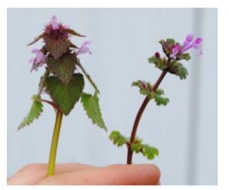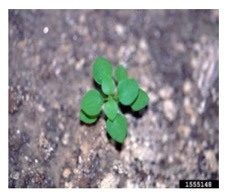Brought to you by: Jonah T. Johnson, MS, CPAg, CCA - Sales Agronomist, PCT | Sunrise
October 30, 2019: Have you checked your fields for post-harvest weed growth? Winter annuals are coming! Check out our fall herbicide application tips!
Agronomic weed control is becoming more and more challenging for a lot of growers across Ohio. Key practices to develop weed-free fields in the spring all begin with controlling weeds in the fall after harvest. Winter annuals germinate in autumn or winter, live through the winter, then bloom in winter or spring. The plants grow and bloom during the cool season when most other plants are dormant or other annuals are in seed form waiting for warmer weather to germinate.
Winter annuals like marestail, chickweed, henbit, red and purple deadnettle and annual bluegrass can all become a dense mat and interfere with planting practices, crop establishment and early-season growth during the successive growing season. Now that harvest is nearing completion for some in Ohio, and rain is in the forecast again, winter-annual weed growth will begin.
Fall weed control aids in removing competing weeds in the spring prior to planting. Depending on a spring-burndown herbicide application completely can be a challenge, all depending on the season. Winter annuals become more difficult to control as they mature, therefore increasing herbicide costs. For some weeds, herbicide rates may simply need to be increased. Whereas, some weed species will require additional herbicides.
My new co-worker, Bryan Reeb, who is my direct counterpart as a Research Agronomist with the PCT | Sunrise group, recently came to work with us from The Ohio State University Extension (OSUE) Weed Science Group. At OSUE, Bryan worked with Dr. Mark Loux, assisting in implementing state weed science research in agronomic crops. Bryan has over 10 years of experience and is a great addition to our team.
Below, Bryan lists some great weed control recommendations:
Fall Herbicide Tips
Purple Deadnettle (left) Henbit (right)

Marestail (Horseweed)

Common Chickweed
Reference:
Pictures: https://www.roundupreadyplus.com/resourcecenter/winter-annual-weed-identification
Winter annuals like marestail, chickweed, henbit, red and purple deadnettle and annual bluegrass can all become a dense mat and interfere with planting practices, crop establishment and early-season growth during the successive growing season. Now that harvest is nearing completion for some in Ohio, and rain is in the forecast again, winter-annual weed growth will begin.
Fall weed control aids in removing competing weeds in the spring prior to planting. Depending on a spring-burndown herbicide application completely can be a challenge, all depending on the season. Winter annuals become more difficult to control as they mature, therefore increasing herbicide costs. For some weeds, herbicide rates may simply need to be increased. Whereas, some weed species will require additional herbicides.
My new co-worker, Bryan Reeb, who is my direct counterpart as a Research Agronomist with the PCT | Sunrise group, recently came to work with us from The Ohio State University Extension (OSUE) Weed Science Group. At OSUE, Bryan worked with Dr. Mark Loux, assisting in implementing state weed science research in agronomic crops. Bryan has over 10 years of experience and is a great addition to our team.
Below, Bryan lists some great weed control recommendations:
Fall Herbicide Tips
- Scout your fields, as more crops are coming off there is more sunlight reaching the ground allowing those dormant weed seeds to begin the germination process, especially with the added moisture in the coming forecast. A clean field today may not be clean in 10 days. Note perennial/winter annuals vs summer annuals. Windshield scouting will not tell full story of what is hiding under the previous crop residue.
- Is it too late to spray a fall herbicide burndown? NO, previous years we have sprayed into December.
- Should I cut my herbicide rate? NO, with weed species and how quickly they adapt there is no excuse to cut the rate below currently labeled rates.
- Should I pull PCT Digester out of my spray mix? At this time no, but be cognizant of the weather and make sure you have at least a 2-day window above freezing to allow the living biological microorganisms to start colonizing. Consider using the 2 pt. vs 1 pt.
- Do I need glyphosate with my 2,4-D or Dicamba? Depends on your past and current weed history of those fields. If there are grass species such as bluegrass and fescues, then adding glyphosate would be advised. Also remember if you’re not already using and 2,4-D/Dicamba premix, adding the addition of dicamba to a glyphosate/2,4-D program will help increase control on chickweed, thistle, dandelions and Marestail/horseweed.
- Fall applications are one of the most inexpensive and effective way to manage resistant Marestail/horseweed. Any marestail plants that are currently in the rosette stage will over winter and become problematic next spring.
- Don’t just clean out all the old jugs and shuttles and immediately throw in the spray tank, first look for contamination and settling issues that may lead to clogged screens and tips on your sprayer.
- Deadnettle and henbit are alternate host’s for soybean cyst nematode.
- Uncontrolled winter annuals can cause spring planting issues due to dense weed mats not allowing soil to dry.

Purple Deadnettle (left) Henbit (right)

Marestail (Horseweed)

Common Chickweed
Reference:
Pictures: https://www.roundupreadyplus.com/resourcecenter/winter-annual-weed-identification